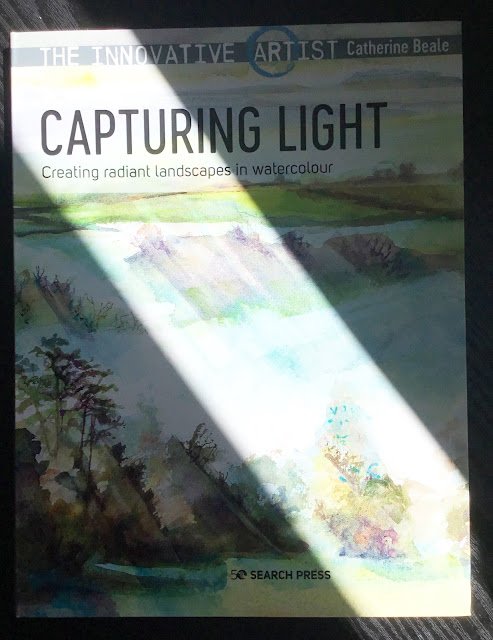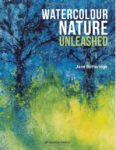What with all the doors and windows in the house being replaced this week, I’ve had too much on to be thinking about to be able to do any painting. So I’ve been doing some reading instead. This book was only published two days ago and I’ve been itching to get my hands on it for a while. Well, I’ve ordered it, received it and read it. Now here comes the review. It’s a 176 page paperback, one of those substantial feeling paperbacks where the covers are folded inwards so the corners won’t bend.
Contents-wise we’re looking at:
– about 30 pages of introduction and on inspiration
– about 10 pages on materials
– about 30 pages on colour, light & shade and composition
– about 50 pages on techniques
– about 60 pages on projects
Let’s go through them all in turn.
The 30 pages at the start felt a bit wishy washy a lot of the time, to be honest. Lots about why Catherine paints, what inspires her to paint and all the different types of light that you can see. In lots of places, there were mentions of going into detail later in the book, so maybe this was more of a teaser section. That’s not to say it was a waste of paper: there was the odd little tip sneaking in. There to keep us on our toes.
Then we had the usual bit on materials. I never learn much from these sections. Colour-wise, Catherine seems to use a huge range of colours, sometimes lots within the same painting. And, from what I can tell in the rest of the book, she uses off the peg greens and purples and isn’t averse to using opaque colours (opaque yellows in particular). But I don’t go into these books seeking to copy everything the authors do: I pick and choose and one thing I won’t be copying here is Catherine’s exact choice of colours.
Then we have three short chapters on colour, light & shade and composition. What I found most interesting here were Catherine’s value plans, where she divided paintings into light, mid-tone and dark areas. I’ve seen other authors doing this but using highly simplified shapes: Catherine’s are more detailed and intricate, which will be important when it comes to protecting some of the important light areas with masking fluid.
At this point it probably sounds as if this book’s not great, in that I wasn’t learning very much. So it’s worth me mentioning here two things about the book that were already making it special. First, Catherine has a voice: her passion comes through in everything she has to say. I also like that she talks in the first person a lot. It’s all I do this and I do that and never you should do this and you must do that. And the second big plus is the artwork. It’s beyond inspiring. I find myself looking at every detail of these paintings trying to work out what Catherine’s done.
So I am actually enjoying this book so far but things are about to get better. Because we now go into a couple of chapters on techniques. Most of this is based around an eight step process for creating a painting. Think of the three step process recommended by
Peter Cronin but widened out into eight steps. Some of Peter’s steps are replaced here by multiple steps but there are also some extra steps that Catherine identifies and the eight steps do make perfect sense. There are plenty of tips and techniques thrown in at all eight stages but the most interesting stage for me was the last one on reviewing the painting and making corrections, which I thought included some great suggestions. After going through this eight step process, Catherine throws in some extra ideas on line and wash painting, creating a sense of mystery and abstractification, albeit an only at a shallow level for the latter.
And then we get to the projects. At this stage of a book I’m normally thinking there’s nothing more to learn and that this will all be padding, pandering to the knitting pattern brigade who only buy art instruction books so that they can get detailed instructions on how to reproduce the author’s paintings. But was I in for a surprise! First, these are demonstrations, not instructions, always important to me. Second, they don’t just tell me what the author did, but why she did things. Why she chose this scene, why she painted in portrait format, why she chose these colours, why she made these corrections at the end. Third, everything relates back to the rest of the book, not just to the eight step painting process but also to the processes that Catherine described around choice of subject and composition. They’re like worked examples, illustrating everything we’ve been taught. And fourth, those paintings are amazing. For the first time since my very early days, I even thought about copying these paintings. And, let me tell you, that says a lot. And just looking at each demo separately, they each seem to have three or four moments of genius within them that I want to mimic at some point, even if they’re not all used in the same painting.
This book just has everything. A voice, the inspiration, the countless ideas, a new process that could well change the way I paint and a robust physical structure and decent number of pages. I can’t wait to get the opportunity to incorporate these ideas into my painting. It definitely joins the galactico club. Five palettes.
🎨🎨🎨🎨🎨
And I hope you all like the photo at the top of this post. The light was shining in just a narrow enough band across my desk. I couldn’t resist.









Leave a Reply